Listen to This Article:
Steamed, boiled, or pan-fried to perfection, the delightful mingling of tender dough, vibrant veggies, and succulent minced meat make Chinese dumplings a culinary treasure. Long believed to bring about wealth and prosperity, Chinese dumplings offer a delicious meal in just one bite.
While often described as easy and fun to make, any culinary student who’s tried their hand at folding them will tell you it’s trickier than it looks—rewarding, yet a test of patience and precision! And with more than a handful of Chinese dumplings to choose from, it’s not always easy knowing where to start first.
This guide will take you through the history of these beloved cooked parcels, highlighting their evolution, popular varieties available, and their impact on the culinary world, both past and present.
By the end, you’ll be eager to try your hand at folding your very own!
What Is a Chinese Dumpling?
Today, Chinese dumplings are well known around the world as popular, healthful foods. By definition, dumplings are pieces of dough that have been wrapped around various fillings and cooked. More often than not, you’ll find that dumpling dough is made of all-purpose flour, with water and salt included. Each of these ingredients is key to giving these bites their texture and delicious taste.
While many dumplings today include shrimp, beef, pork, and other meat products, alternate versions are available for vegans and vegetarians. For those interested in meat-free, plant-based diets, dumplings with onion and mushroom fillings have become increasingly popular.
Many Chinese dumplings come in bao or gao forms. While bao dumplings are purse-shaped and round, gao dumplings are shaped like crescents. Both are mouthwatering and a treat to indulge in.
From Pragmatic Medicine to Appetizing Cuisine: The Fascinating History of Chinese Dumplings
The history of Chinese dumplings is both rich and fascinating, tracing back to the Han Dynasty around 206 B.C. to 220 A.D. During this time, the renowned medical practitioner Zhang Zhongjing observed many in his community suffering from frostbite, particularly around their ears during the harsh winter. Inspired to help, Zhang created a food that would not only nourish but also symbolize warmth and healing. He crafted dumplings filled with mutton, herbs, and chili, shaping them to resemble ears, in line with the traditional belief that like cures like—a common concept in many ancient medical practices.
As centuries passed, the dumpling evolved beyond its medicinal origins. It became a staple for preserving meat during colder months and making efficient use of surplus grains. The culinary techniques and cultural significance of Chinese dumplings continued to grow, influencing and being influenced by neighboring regions through trade and cultural exchange.
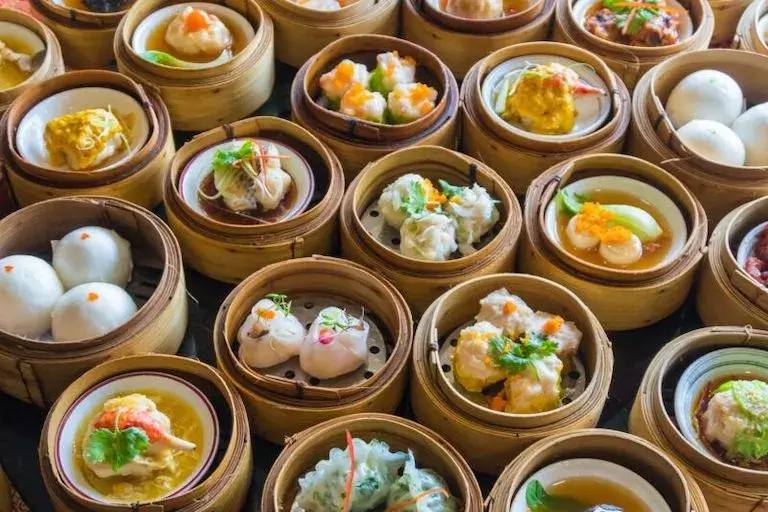
A feast of Chinese flavors: Dim sum delights in traditional bamboo steamers.
Exploring 8 Types of Chinese Dumplings
Unique and multifaceted, no two Chinese dumplings are exactly alike.
While Shui Jiao and Guo Tie dumplings often come with similar wrapping and fillings, their cooking methods differ. In contrast, Sheng Jian Bao and Xiao Lang Bao are celebrated for their doughy texture and rich fillings of jellified broth, seafood, and pork.
Let’s explore the textures and tastes of eight popular Chinese dumpling styles – in no particular order.
1. Shui Jiao
Translated to “water dumpling,” in English, Shui Jiao generally contains pork, grated ginger, and chopped scallions that are then placed in a thin wrapper made of water and flour. As their name suggests, these dumplings are boiled in water until they turn translucent and float to the top, resulting in a soft and chewy texture. They are most commonly enjoyed with dipping sauces, such as black vinegar mixed with soy sauce or chili oil.
These dumplings are commonly a staple during Chinese New Year and other celebrations or family gatherings as symbols of wealth and reunion, often resembling ancient Chinese gold ingots.
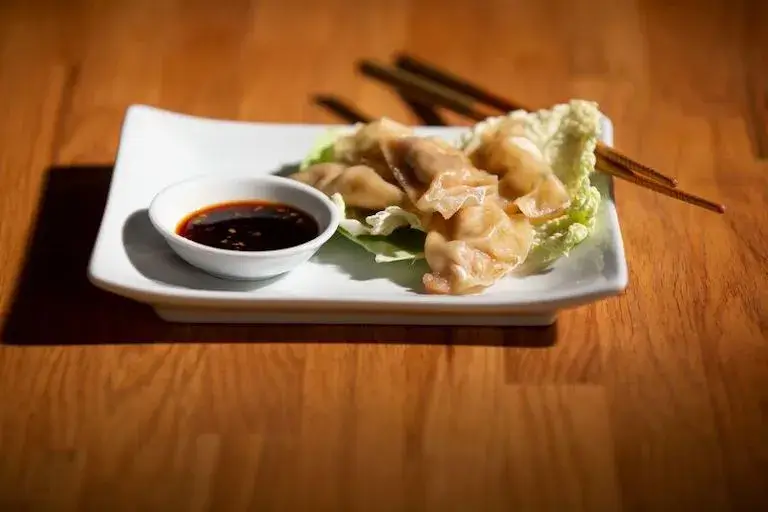
Shui Jiao dumplings are named for their cooking method—boiled in water until translucent and floating.
2. Guo Tie
Translated to “potstickers” in English, Guo Tie is celebrated worldwide for its cooking method which creates a delicious contrast in textures. These dumplings are first pan-fried to create a crisp, golden underside, then covered and steamed to ensure the filling is properly cooked. Its circle-shaped wrappers are commonly made with water and flour, then filled with pork and cabbage or a similar combination of minced meat and vegetables. To serve, they are often dipped in chili oil, vinegar, and soy sauce. Guo Tie perfectly blends textures, with deliciously tender tops and crisp, crunchy underbellies.
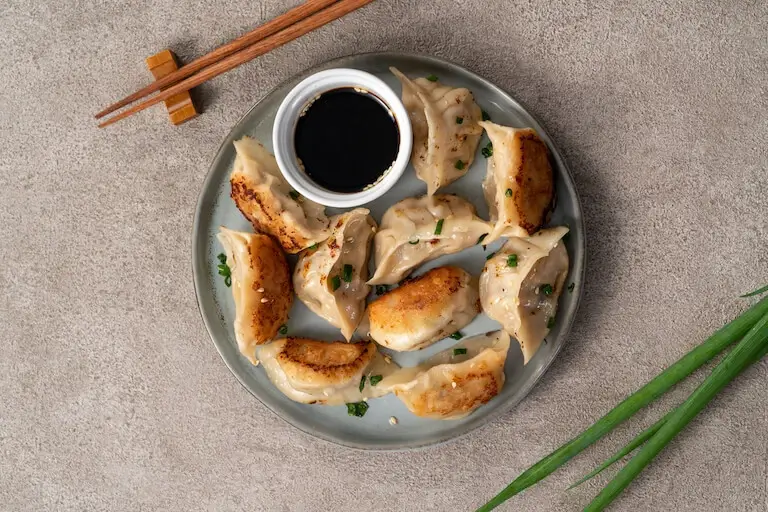
Golden and crispy: Guo Tie potstickers with perfectly pan-fried undersides and tender tops, ideal for dipping.
3. Wontons
Wontons, originating from North China, showcase regional culinary variations that make them a staple in Chinese cuisine. These dumplings are notably more tender and delicate due to their thin, square wrappers, crafted from a mix of wheat flour, water, and egg.
Typically, wontons are filled with shrimp and ground pork and gently boiled in chicken broth. However, regional flavors shine through in places like Shanghai, where you might find wontons stuffed with minced pork and bok choy in a savory soup. In Sichuan province, they take a different twist—folded into triangles and tantalizingly served with sesame paste and chili oil. Whether steamed, boiled, or fried, each style of wonton offers a unique taste experience.
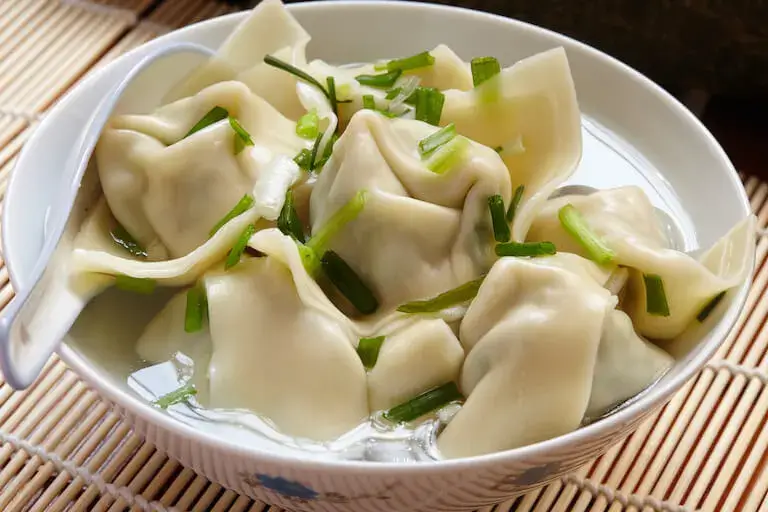
Wontons are one of the most popular types of Chinese dumplings.
4. Xiao Long Bao
Colloquially known as “soup dumplings,” Xiao Long Bao are not only filled with meat but also contain a rich, gelatinous broth that liquefies when steamed. These dumplings come with doughy wrappers and should be eaten with care, due to the fillings. To enjoy them, you’ll want to take a small bite first to sip the hot soup before eating the rest, often dipped in black vinegar with ginger to enhance the flavor and cool the filling.
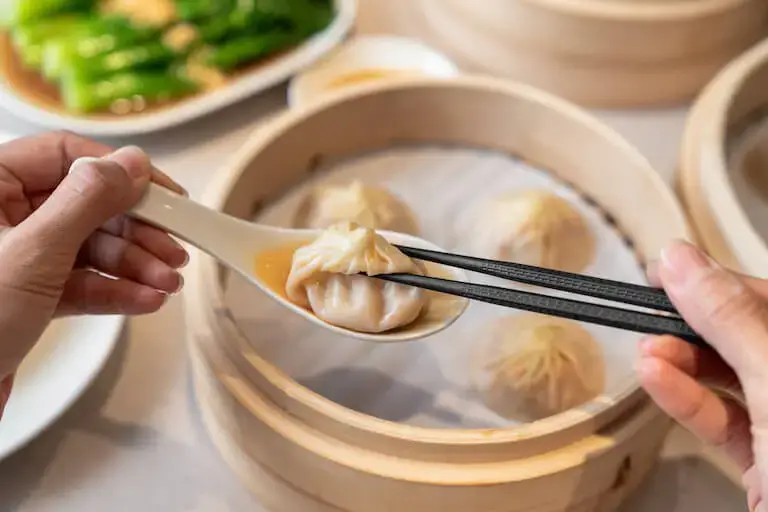
Savor the burst of flavor with each bite of Xiao Long Bao.
5. Sheng Jian Bao
Sheng Jian Bao, affectionately known as pan-fried buns, are a beloved street food from Shanghai. These buns stand out with their delightful contrast of textures—from the crispy bottom to the soft, yeasted dough and the juicy, flavorful pork filling seasoned with ginger, soy sauce, sugar, and sometimes Shaoxing wine. Like Xiao Long Bao, they contain a key feature: a gelatinized broth that bursts with juiciness when one bites into it.
Unlike Xiao Long Bao though which is only steamed, Sheng Jian Bao are first pan-fried to create a crispy base, then steamed to perfection, ensuring the filling is thoroughly cooked while maintaining a fluffy texture. These dumplings are garnished with sesame seeds and green onions, offering a nice texture and fresh flavor.
The contrast between the crispy bottom, the soft bao bun, and the juicy, flavorful filling makes Sheng Jian Bao truly unique—and a must-try!
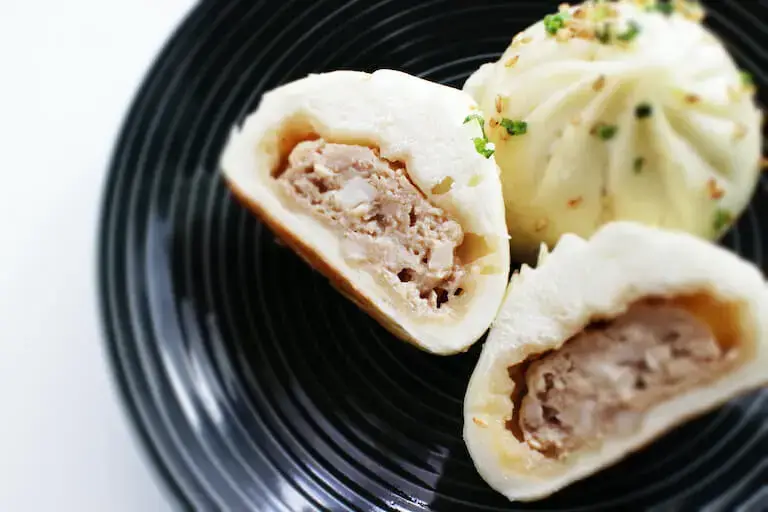
Bite into the crispy and juicy Sheng Jian Bao, a Shanghai street food favorite.
6. Siu Mai
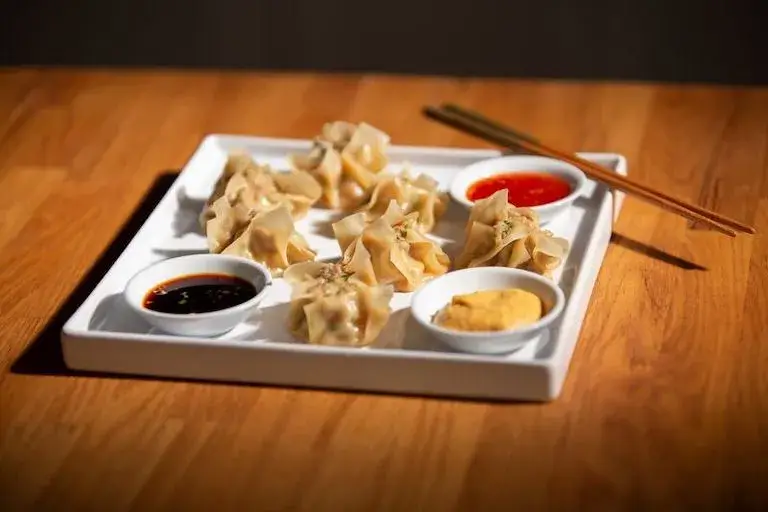
Sui Mai dumplings feature a distinctive open-top, basket-like shape that showcases their tasty fillings.
Originally from South China, Siu Mai (also known as shumai) is distinct for its basket-like shape and open tops that showcase the filling, all encased in thin, wheat dough wrappers. They’re regularly served in dim sum restaurants, and filled with shrimp, ground pork, green onion, ginger, and mushrooms. Similar to other dim sum dishes, these dumplings are steamed in bamboo baskets to keep the filling juicy and tender, before finally being adorned with carrot or orange roe on top, adding a splash of color.
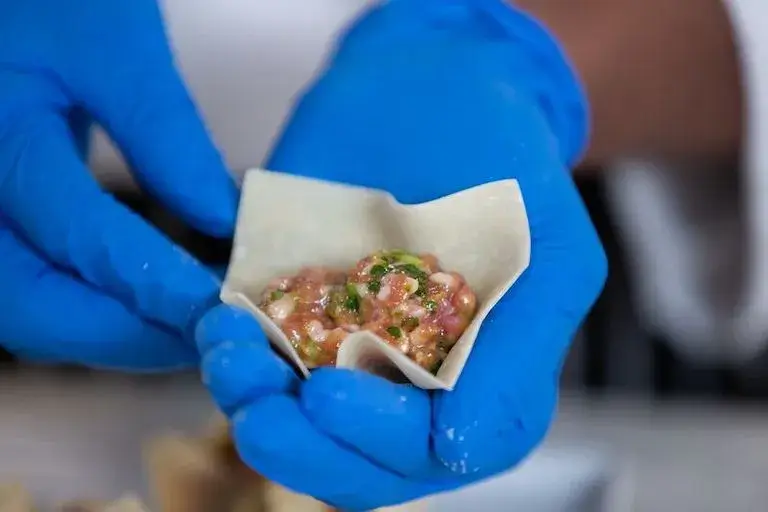
Siu Mai’s open tops make them a beginner-friendly choice compared to the more intricate pleated dumplings.
7. Baozi
Widely known for their bun-like, wheat-based dough wrappings, traditional Baozi dumplings come in multiple variations with both sweet and savory forms. Char Sui Boa has barbecued pork fillings, while Tangbaozi is filled with broth. You’ll find sweet red bean paste in Doushabao dumplings and sweet yellow custard in Naihuangbao dumplings. Nontraditional Baozi, on the other hand, is known to include curried chicken, glazed mushrooms, bulgogi beef, and tofu. Cooked in bamboo steamers, Baozi maintain their soft, pale exteriors and tender fillings, offering a delightfully chewy texture.
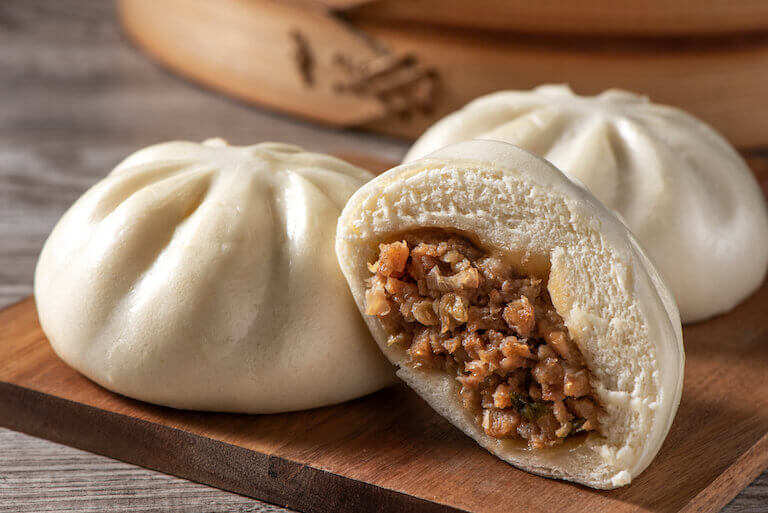
Delightfully chewy baozi can feature sweet or more savory fillings, like succulent barbecued pork.
8. Har Gow
Translated to “shrimp dumpling” in English, Har Gow is oval or crescent-shaped with a translucent wrapper made of wheat and tapioca starch. These dumplings are filled with bamboo shoots, pork fat, and shrimp and meticulously pleated with 7-10 folds. Once steamed, Har Gow achieves a firm and juicy texture for which it has become famous. To complement the delicate flavor of the shrimp, these dumplings are commonly enjoyed with light soy sauce.
This type of dumpling tests a chef’s skill because the skin needs to be thin and translucent enough to see the shrimp within, but strong enough to hold its fillings without breaking.
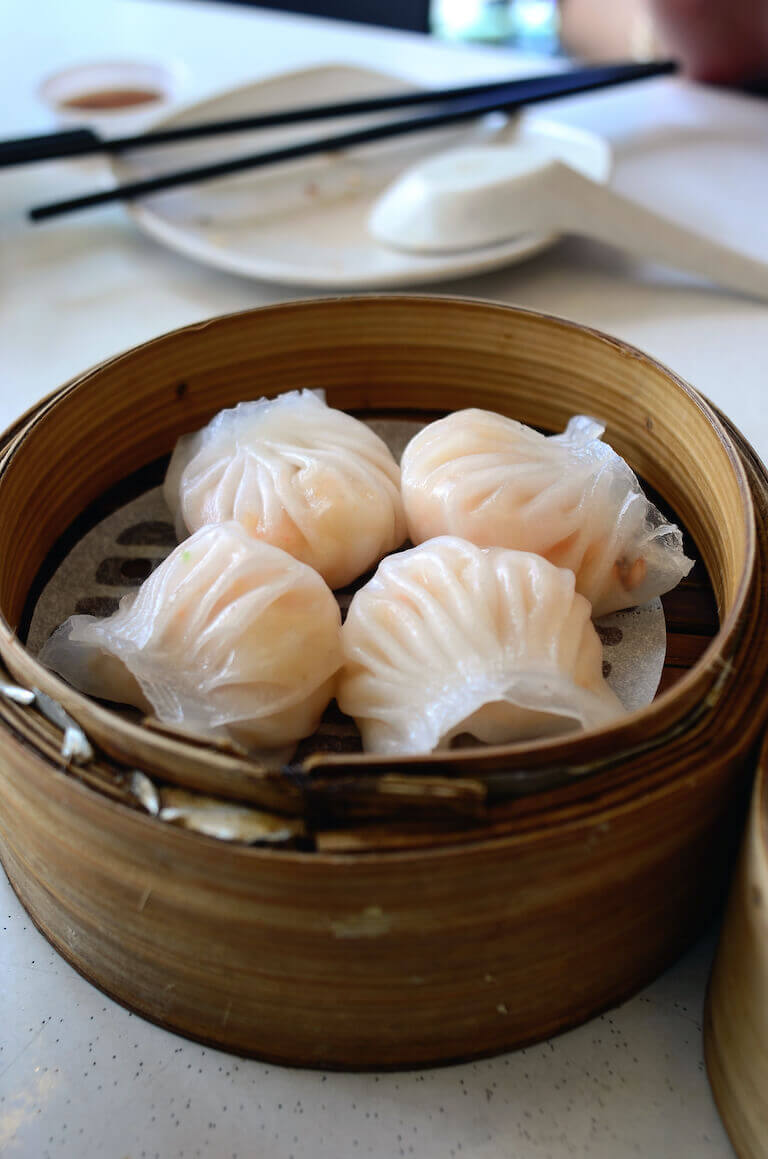
Har Gow: The art of translucent dumplings filled with fresh shrimp.
Future Innovations Driven By Chinese Dumplings
Chinese dumplings are diverse and popular dishes with unique backstories. But what about their future?
In some cases, first- and second-generation Chinese immigrants are experimenting with different fillings and approaches. Elsewhere, chefs have started exploring various vegan and gluten-free versions of Chinese dumplings in order to broaden their overall appeal. They use 3D food printers to create various dumpling shapes, while taking advantage of Smart kitchen appliances which can quickly fold dumplings.
Given the ever-evolving nature of the culinary scene, knowing the who’s who of Chinese dumplings—and various ways of creating them —can pay off big-time.
Chinese Dumplings Are a Staple in the Culinary Scene
Chinese dumplings are a meal that bring historical significance while also continuing to evolve. With these bites, you can uphold traditional Chinese values of unity, togetherness, and celebration while becoming more versatile in the kitchen.
If you’d like to find out more about Chinese dumplings and how to further grow in the evolving culinary arts world, getting hands-on lessons from a top culinary school can be invaluable.
Contact us to find out how the Auguste Escoffier School of Culinary Arts can enhance your culinary skills.

